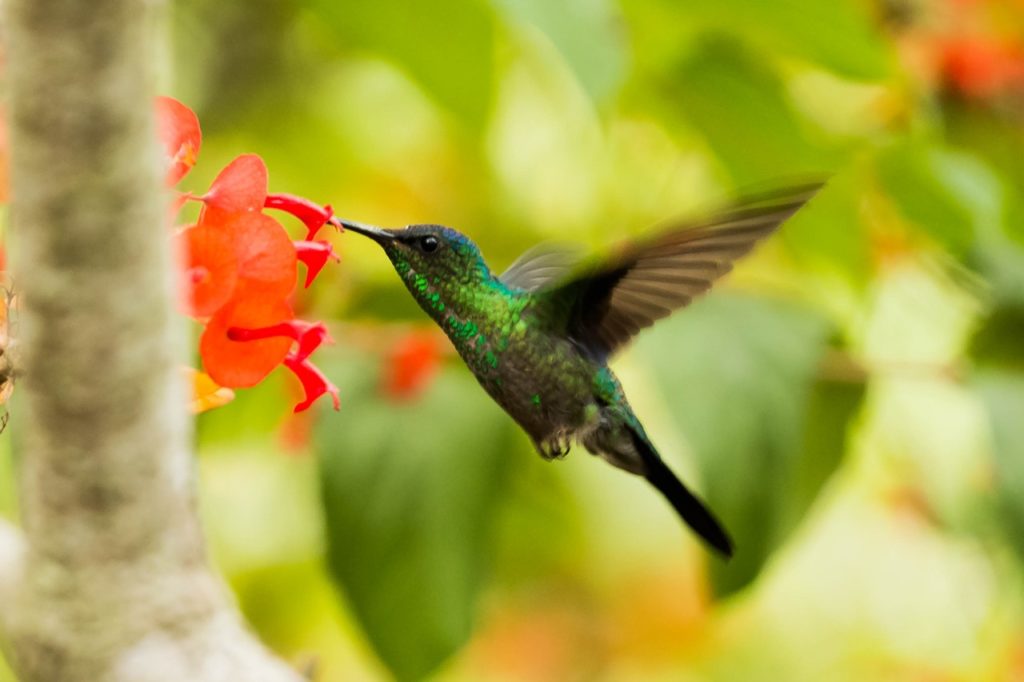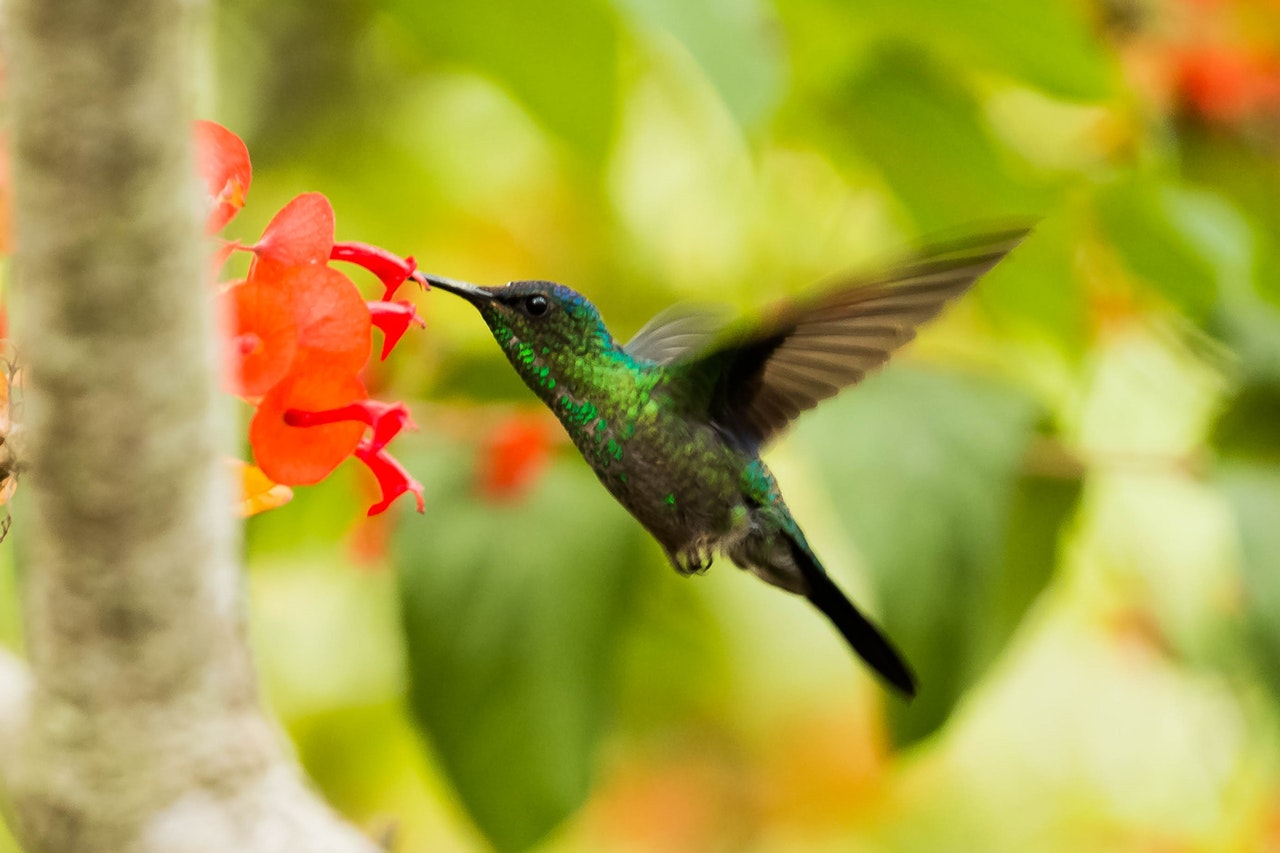
How do hummingbirds flap their wings so fast? By having very strong, fast twitch chest muscles, by twisting their wings instead of flapping them, and by being able to use oxygen and energy very quickly.
There are 361 species of hummingbird altogether. The smallest species grow to about 5 cm and weigh 2 grams The largest species grow to about 23 cm and weigh 24 grams. The largest species are called Giant Hummingbirds and they are found in Bolivia and Peru. Hummingbirds can catch flying insects, but they are adapted to drink the nectar from flowers. When they eat insects, they hover in a swarm of insects and eat their fill. When they eat nectar, they hover in front of the flower and stick their flexible beaks into the flower. They extend their long tongue, which has hollow tubes in it, into the flower and drink the nectar. Nectar is usually 55% sucrose, 24% glucose, and 21% fructose. The hummingbird is able to keep its head perfectly still while it is flying. The smaller hummingbirds can flap their wings at 80 beats per second.
Before we look at how hummingbirds flap their wings so fast, let’s look at why. Anything that flies has to deal with the four forces of flight: weight, lift, drag, and thrust. If a bird is lighter, it suffers less from weight and drag, but it will have smaller wings, so it will have less lift and thrust. If a bird has larger wings and bigger muscles, it has more thrust and lift, but it will be bigger, so it will suffer more from weight and drag. The size of the wing in relation to the bird is called “wing loading”. This is the ratio of the mass of the bird to the total wing area and is calculated by using mass (kg) / wing area (m2). Birds can fly up to 20kg/m2, but that is the upper limit. Above this weight, the wings would have to be too big. If a bird has a low wing load, that means it can generate more lift with each flap of its wings and doesn’t have to flap much. Frigatebirds have the lowest wing load of any bird. Their wings have a span of 2.3 m and they soar for weeks without landing. If a bird has a high wing load, it cannot generate much lift with each flap and has to flap a lot. Hummingbirds have a very high wing load, which is why they have to flap so quickly. This can be demonstrated by looking at the Giant Hummingbird. They are two times larger than the next largest hummingbird and they only flap their wings 15 times a second. They can even soar. This is because their wing load is lower than a smaller hummingbird. A reason hummingbirds have evolved to flap their wings so quickly is that larger wings give less lift when a bird is flying slowly, so larger birds cannot hover in the same way that smaller birds can. Hummingbirds need to be able to hover to get at their food.
So, how do hummingbirds flap their wings so fast? The first thing to look at is the way they flap their wings. Nearly all other birds flap their wings up and down. All of the thrust is delivered on the down stroke. When they bring their wings up to flap again, they collapse them against the body to reduce air resistance and limit the amount of down force. Hummingbirds don’t do this. Hummingbirds twist their humerus, which rotates the wing as they flap. This movement turns the wing over and gives them lift on both the upstroke and the downstroke. This lets them get twice as much lift with one flap. They are able to do this because the wing is only attached at the shoulder. They share this ability with insects, and it helps them hover. If they only got lift on the downstroke, they would not be able to support their weight on the upstroke and would need to move forward through the air.
Hummingbird physiology is adapted to let them flap their wings so fast. Their muscles are comprised of fast twitch fibers, which can move extremely quickly, but they require massive amounts of oxygen, energy, and blood. To sustain this, hummingbirds have evolved three things. Firstly, their hearts beat incredibly quickly. The resting heartbeat of a hummingbird is about 300 beats per minute and that rises to 1,263 beats per minute when they are flying. That pumps oxygen and energy to the muscles. The second thing is their breathing. To get that much oxygen to their muscles, they breathe 300 times a minute when resting and 500 times a minute when flying. They have the highest oxygen requirement of all vertebrates, and they take in 100% more oxygen than the shrew, which is the same size. They also have the highest density of red blood cells of any vertebrate as well. The third thing is their energy. They drink the nectar of flowers, which is almost entirely sugar. Hummingbirds have the highest metabolic rate of any animal, and they can convert the sugars they have eaten into energy within 30 minutes. Because they rely on nectar so much, they have an enlarged hippocampus, which lets them remember where flowers are and where they have already been. Interestingly, they also have fat stores, which they rely on when they are sleeping and if they migrate.
The hummingbird’s biggest secret is possibly the main reason why they can flap their wings so fast. Most of the time, they perch on branches and don’t move. They wouldn’t be able to sustain their hovering flight for too long without starving. And this is what I learned today.
Sources
https://en.wikipedia.org/wiki/Frigatebird
https://www.sciencelearn.org.nz/resources/301-wing-loading
https://www.sciencelearn.org.nz/resources/303-how-birds-fly
https://en.wikipedia.org/wiki/Giant_hummingbird
https://en.wikipedia.org/wiki/Hummingbird
https://www.nature.com/articles/nature.2011.9639
https://www.sciencedirect.com/science/article/pii/S0960982212004770


[…] This means they can only flap their wings about 30 times a second. This is about twice as fast as a hummingbird. However, because their muscles are connected to each wing, they can move their wings […]
[…] to use a lot of energy. It is not easy to flap their wings enough to stay airborne. Dragonflies, hummingbirds, and of course, larger birds, have to eat a large amount of food to be able to fly. Many birds […]